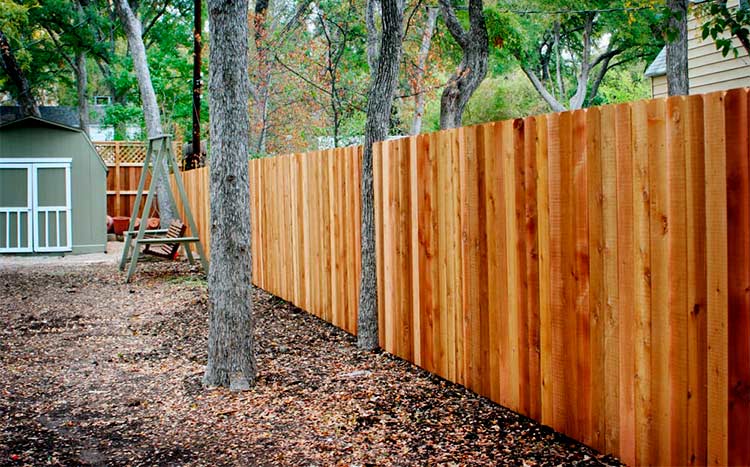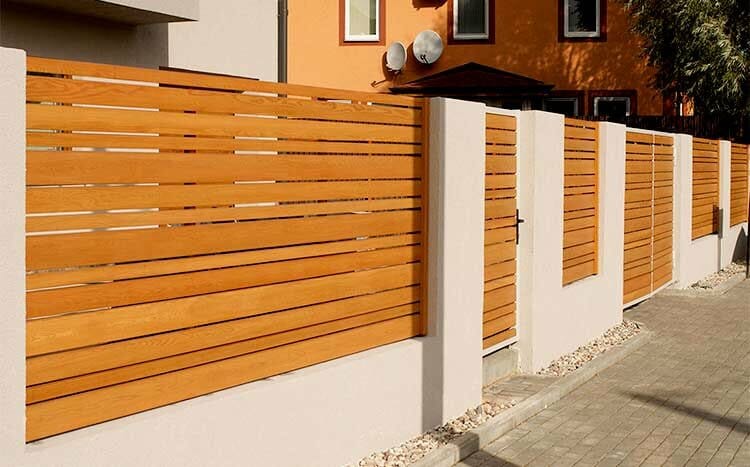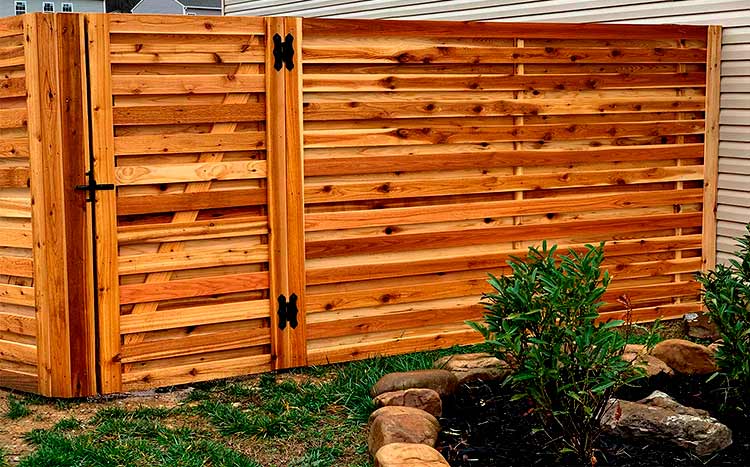Cedar and redwood are frequently selected by homeowners as their fencing materials of choice. These types of wood are favored because of their long-lasting nature and exceptional resistance to moisture, which frequently makes the choice between them a difficult one.
Redwood fencing performs better in terms of quality, durability, longevity, and appearance compared to a cedar fence. However, redwood fencing is more expensive to install ($28 – $55 per sq. ft) than cedar fencing ($12.50 – $33 per sq. ft), as it can be difficult to source.
Cedar and redwood installation costs vary considerably across US regions. It would be helpful to indicate your region while getting a free estimate from this website.
What we cover
ToggleCedar vs. redwood fence cost per square foot
The average cost to install a cedar or redwood fence on your property is between $15 to $35 per square foot, with labor costs averaging $20-$50 per hour depending on the property size and the scope of work.
Expect to pay significantly higher for a redwood fence. A 200-linear foot redwood fence costs around $6,270. Redwood fence cost per foot is around $31.35.
You can save costs by building with narrow boards instead of the more expensive wide boards. It would be good to remember that lumber costs fluctuate each season, often influenced by weather and availability. We recommend taking a trip to a local sawmill to check out wood board prices before getting a professional estimate for your proposed fencing project.

Use this FREE service
HomeGardenGuides.com is a free service that quickly matches you with top-voted local contractors.
You can get three estimates fast by real certified experts in your area in just 2 minutes.
- Scroll to the top of the page and enter your Zip code.
- Answer questions about your fencing project.
- Your project details are forwarded to three local experts. They will send you a price estimate for the job and some friendly advice.
IMPORTANT: There is no obligation to hire. This is a free tool and service to be used at your pleasure.

Cedar fence cost
Professional rates for installing cedar fences range between $12.50 to $33 per square foot, depending on the project size, material type, and scope of work involved. A DIY cedar fence installation can range from $6-$17 per square foot in material costs. The price range for a 150-foot cedar fencing project is between $2,000 to $4,500.
You can reduce material costs by selecting lower-grade wood panels for your fence. These typically have unsightly knots and other flaws, which you can cover with a coat of paint.
It is a common understanding that style and design are the most critical factors determining your overall costs. An elaborate fencing design will consume more materials and labor hours than a simple design concept.
Cedar fence cost by wood type
Several cedar tree species provide excellent lumber for fencing construction. The most popular cedar type is western red cedar, and the most expensive is white cedar. We will be examining the fencing costs of both cedar types.
Western red cedar
This cedar variety has a rich gall tone that appeals to owners of most high-end properties. It cost homeowners between $21 to $30 per linear foot to put up a western red cedar fence on their property.
Northern white cedar
Northern white cedar is a more expensive cedar wood type that is popular in high-end decorative fencing applications. A high-grade white cedar board fence can cost around $11,000, with an average lifespan of about 15 years, giving an excellent return on your initial investment.
Redwood Fence Cost
The cost of a redwood fence varies depending on lumber availability ad market prices at the time, but homeowners normally pay between $28 to $55 to install a redwood fence on their property, depending on the board quality, project size, and work scope. The average cost to have a contractor install a redwood fence is approximately $41.50, with a low of $35 and a high of $45. Redwood prices (like other wood types) are experiencing a post-COVID surge due to demand from homeowners catching up on home improvement projects delayed during the quarantine.
| Type | QTY | Cedar | Redwood |
|---|---|---|---|
| Fencing cost (installed) | per square foot | $12.50 - $33 | $28 - $55 |
| Fencing cost materials | per square foot | $8 - $18 | $11 - $35 |
| Fencing labor cost | Per hour | $20 - $50 | $20 - $50 |
| Average fencing cost (installed) | 200 linear ft | $3,135 | $6,270 |
Cedar fencing cost by fence type
You can choose to have your cedar fencing in any design, including cedar picket fence, cedar privacy fence, cedar lattice fence, e.t.c, depending on your budget, needs, tastes, and neighborhood requirements.
Cedar picket fence
A picket fence is that quintessentially American icon that adds a wholesome appeal to any home. Installing a 6-foot tall cedar picket fence costs between $8-$12 per square foot, depending on the quality of the cedar used.
Cedar privacy fence
Privacy fences provide your property with a complete screen keeping your private moments out of curious eyes. The average cost of a complete privacy cedar fence is $17 per square foot. A semi-privacy cedar fence with 2-inch space pickets costs around $24 per square foot, while a privacy cedar fence with a lattice top can cost up to $33 per square foot.
Redwood fencing cost by fence type
Redwood is renowned for its versatility, and you can install your redwood in any design of your choice, depending on your budget, needs, tastes, and neighborhood requirements. Popular designs include redwood picket fence, redwood privacy fence, redwood lattice fence, e.t.c.
Redwood picket fence
A 6-foot tall redwood picket fence with a 2-inch gap covering the front section of a standard lot can set you back $1,600 to $3,000 in labor and material costs. Redwood is not available locally in many parts of the country, and contractors often incur high haulage costs to ship them to the project site.
Redwood privacy fence
Prices for redwood privacy fences range from $83-$159, depending on the height and width, fence design, and wood quality. A 6-ft high by 8-ft wide Redwood Dog Ear privacy fence panel costs $89.98, while a 6-ft tall by 8-ft wide Redwood lattice-top privacy fence panel ranges from $123 to $159, depending on the board grade.
Visible differences between cedar and redwood fencing
The difference in the appearance of cedar or redwood fencing is striking. This is primarily due to a couple of factors, namely, wood color and grain. Both factors have a direct impact on fencing appeal and how they hold up to outdoor conditions.
| Cedar | Redwood | |
|---|---|---|
| Color | Each cedar species has its distinctive wood color by which it can be identified. Yellow cedar has a unique golden tone, red cedar shares color similarities with the redwood tee, and white cedar is easily recognizable by its pale-colored lumber. The western red cedar has a natural-looking yellowish hue when it is cut. This wood color is an excellent choice for homeowners who want to paint or stain their fencing after installation. | Redwood fencing has a gorgeous brown-red shade thatdoesn't require painting or staining after installation. You get deeper red hues with higher grade heartwoods, hence the name 'redwood. However, untreated redwood tends to fade with the color turning into an ugly gray over a period. |
| Grain/grade | Cedar has a tight and uniform grain distribution throughout. With a maximum of 10 grades ( for white cedar), cedar offers enough grains or knots required for any fencing project. | Redwood has a wider and relatively uniform grain spacing than cedar due to its faster growth rate (7 ft per annum). Homeowners have a choice of purchasing 30 grades with varying degrees of quality, ranging from a few knots to clear wood. Redwood lumber has a very smooth surface typically free of flaws and defects, making it an excellent choice for premium fencing applications. |

Key considerations when choosing between cedar or redwood fence
Your fencing performance requirements and location are part of the critical considerations deciding your final selection. In this section, we would be comparing cedar and redwood fencing in terms of maintenance, durability, lifespan e.t.c.
| Cedar | Redwood | |
|---|---|---|
| Maintenance | Cedar fencing is expensive to maintain, requiring annual painting or staining to prevent the wood from fading into a silvery patina over a period. Cedar contains tannin, an insect repellent that prevents pest damage. Applying a semi-transparent stain on your cedar fence protects the wood's natural color and keeps it from fading. Annual cleaning to remove dirt, stains, and mildew is essential to prevent wood degradation. Standard cleaning methods include water and soap solutions. Wiping the fencing boards, a bleach solution can remove mildew stains. Do not use a power washer. | It has significantly lower maintenance costs due to the high presence of natural oils, including tannin, which prevents pest and moisture damage. Cleaning a redwood fence is similar to cedar. Homeowners can use a combination of water and soap to remove dirt and stains. Applying a semi-transparent, oil-based stain every three or five years will preserve redwood fencing appearance and color. |
| Durability | Using the Janka scale, cedar has a hardness rating ranging from 320 lbs pounds per square foot (white cedar) to 350 lbs pounds per square foot, making cedar fencing less durable than a redwood fence with a Janka rating of 450 lbs pounds per square foot. But in reality, a well-installed cedar fence can have an approximate lifespan as a redwood fence of similar size. | Redwood has a 23% higher durability rating than cedar. Meaning a redwood fence is denser, stronger, and less susceptible to damage than a cedar fence. |
| Moisture resistance | The natural oils in cedar fencing act as a temporary natural water-resistant feature protecting your cedar fencing from moisture damage, including rotting, twisting, or warping. However, the natural oils drain or dry out over time, and without staining or sealing, the cedar fence may begin to swell or twist. | Redwood has high natural oil content, which provides a near-permanent water-resistant feature. This feature also includes redwood fencing with moisture absorption and release abilities protecting the wooden boards from water saturation which leads to swelling and warping. Redwood fencing is highly popular among coastal residences and in areas with high levels of snow or rainfall. |
| Availability | With an annual production of around 1 billion board feet per annum, cedar is widely available and sold in major box stores across the entire United States. The eastern white cedar variety is popular along the Eastern Seaboard, while western red cedar is sold nationwide. | Redwood lumber can be difficult to source unless you reside in the Northwestern United States, a popular fencing choice. Homeowners living in other regions would need to order through their local lumber dealer and wait to ship the redwood. |
| Environmental sustainability | Cedar is certified by the Forest Stewardship Council. It is a 100% natural and biodegradable product. Reports indicate that second-growth western red cedar is only recently being harvested, providing a product of exceptional quality. | Redwood is certified by the Forest Stewardship Council. It is a 100% natural and biodegradable product and a sustainable product. According to a Humbolt Redwood report, the company grows more trees than they harvest annually. |
| Lifespan | A cedar fencing lifespan depends on several factors, which include maintenance and climate conditions. A well-maintained cedar fence in a dry, hot climate can last for more than 15 years with minimal maintenance. However, the average lifespan of a well-maintained cedar fence in a wet environment is 10 to 15 years. The lifespan of a well-maintained non-pressure treated cedar fence is 15-30 years. In comparison, a pressure-treated cedar fence can last for 40 years. | The average lifespan of a redwood fence with minimal maintenance is about 30 years. |
Cedar vs. redwood fence pros and cons
Cedar and redwood fencing offer several practical benefits, which makes it difficult for homeowners to choose between both. Understanding the advantages and drawbacks of each food fence type is the key to making informed choices. Here are the pros and cons of cedar and redwood fencing.
Cedar fencing
Pros.
- Materials for cedar fencing are readily available, and the supply isn’t limited to certain areas.
- Cedar fencing is relatively inexpensive, making it a more affordable fencing option.
- You can paint or stain a cedar fence, depending on your preference.
- Cedar fencing offers exceptional durability and excellent moisture-resistant performance at a reasonable cost.
Cons.
- Cedar fencing requires periodic maintenance, which can be expensive.
- Cedar fencing requires annual painting or staining to prevent the wood from fading into a silver-gray color.
- Although, cedar fencing has moisture resistance properties. It needs sealing to prevent moisture damage.
- It is less durable than other wood t types, e.g., redwood. And is highly prone to damage from scratches and scuffing.
Redwood
Pros.
- Redwood fence has an unmatched natural beauty.
- Redwood fencing is highly durable and resistant to pests and moisture.
- Redwood fencing requires minimal maintenance over time, making it a cost-effective fencing option.
- Redwood fencing has an exceptionally long lifespan than most fences.
Cons.
- Redwood fencing is expensive to install.
- The wood is not readily available and can be difficult to source.
- The fasteners on a redwood fence can stain the wood.
FAQ's
No, it is not necessary to seal a redwood fence. However, you may choose to perform periodic refinishing of painted or stained redwood fences every couple of years to maintain the great looks.
Sealing a cedar fence is optional. Cedar contains tannin, a moisture repelling chemical that prevents wood rot or decay. Most homeowners often apply a thin layer of paint or protective sealant for additional protection against moisture and UV rays.













